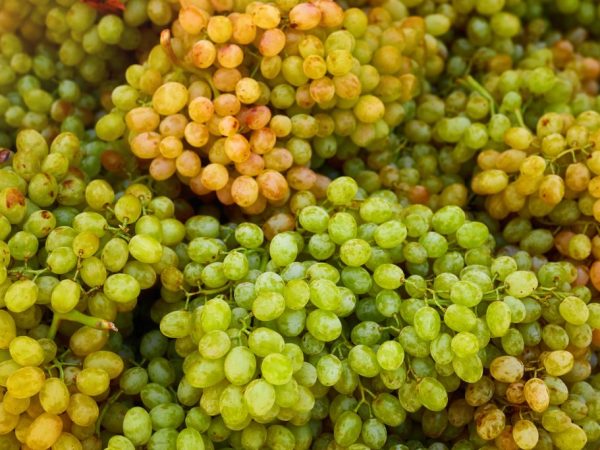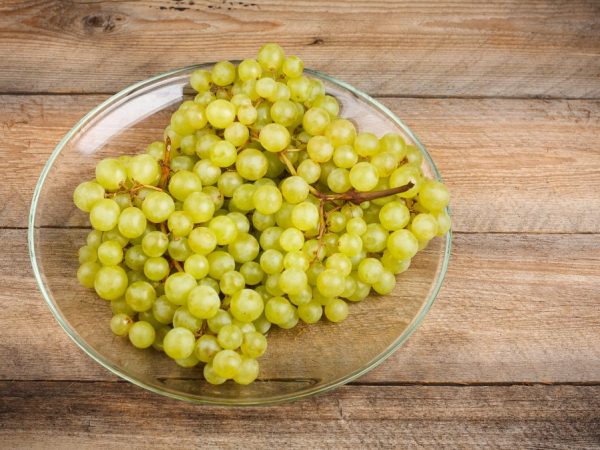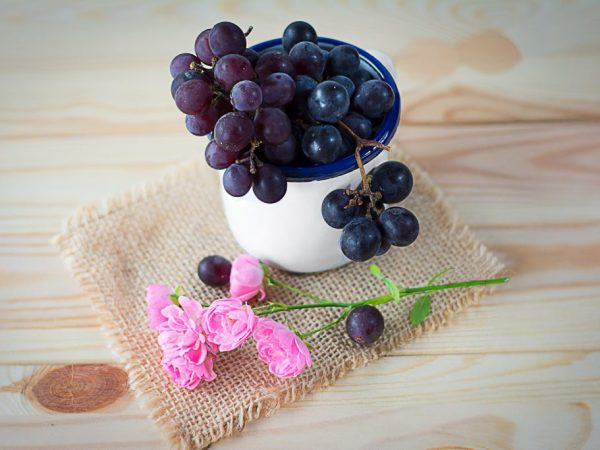Description of Kishmish grape varieties
Klyuchikov's raisins are also called raisins. They stand out from the rest by the lack of seeds. There are about 70 species in total.

Description of Kishmish grape varieties
Zaporizhzhya
Grape Kishmish Zaporozhye belongs to the III-IV class of seedlessness. There are about 70 varieties of this species. It was bred in the city of Zaporozhye, crossing the species Rusbol with Victoria.
The grape variety Kishmish Zaporozhye serves as a pollinator for early-middle, late Vineyards. The culture is frost-resistant, tolerates low temperatures down to -25 ° C. Differs in a stable harvest. It is completely pollinated and often overloaded with fruits, which forces gardeners to thin out the ovaries.
Description of the bush
Shoots have an average and high growth rate, especially in rootstocks C 04, Kober 5BB. Shoots can ripen completely.
Bunches of Kishmish Zaporozhye are distinguished by a pointed shape, a low density of distribution of berries. They weigh 1300-1500 g.
The berries are identical in shape elongated, differ in their small size - 18 × 16 mm. dark grapes - reddish or lilac. The pulp is juicy, fleshy, reminiscent of marmalade. The presence of rudiments and seeds does not affect the taste.
Disadvantages of the variety
Disadvantages of Kishmish Zaporozhye:
- heavy separation of berries from the bunch stem;
- proliferation of many shoots;
- attack of berries by wasps because of their sweetness.
The plant has poor resistance in the fight against fungal diseases: downy mildew, powdery mildew, powdery mildew, gray mold. Preventive, curative treatment with fungicides is included in the main care of the plant.
Moldavian

Very productive variety
The medium-late variety belongs to the I-II class of seedlessness. It was bred by the breeder MS Zhuravlev from NPO Vierul, crossing the Pobeda variety with pink Kishmish.
Distinctive characteristic of the variety:
- high productivity;
- rapid vegetative development;
- early maturity.
From the beginning of the opening of the buds until the full ripening of the fruit, 150-160 days pass. The variety is characterized by good transportability, shelf life is 6-7 months. It is eaten fresh and dried. Kishmish (raisins) are large and tasty.
Description of the bush
Moldavian Kishmish is a vigorous plant. Shoots are able to ripen quickly.
The bush has leaves of medium to large size, with 4-5 lobes, elongated in shape. They are smooth and shiny in structure. The edges are folded up.
The bunch is small - 0.7-1.2 kg. Its shape is cylindrical, narrowed to the lower edge, branched, sometimes with wings. Kishmish Moldavsky has flowers for women and men. The fruit has a thin but firm skin. They are round or slightly elongated, lilac shade. The surface is covered with a thick wax coating. The fruits are fleshy, sweet.
Disadvantages of the variety
Does not possess natural immunity to fight fungal diseases. It is a relatively frost-resistant plant.
Requires winter cover even in the southern latitudes of the country.Under cover with mulching, it endures winter frosts down to -18 ° C and return spring frosts.
Dream

Kishmish comes in different colors
The culture belongs to the I class of seedlessness.
Ripens in 120-130 days. From the beginning of the growing season to harvest, 125-135 days pass. The yield of this Kishmish grape variety is 115-120 kg / ha.
The culture has high commercial qualities. During transportation it is well transported and stored.
Description of the bush
The flower is bisexual. Shoots ripen quickly. When pruning a bush, leave up to 40 ovaries. The fruiting shoot is cut off, leaving 7-8 eyes.
Bunch of medium size, elongated shape. It has many branches.
The fruits of the raisin variety are medium, oval in shape with a thin tearing skin. Fruit color - from amber pink to dark pink. The pulp is juicy, fleshy. The berries ripen in early September.
Disadvantages of the variety
Dream - raisins grapes, which have a low degree of frost resistance. Withstands temperatures up to -15-18 ° C.
Has an average immunity to fungal diseases:
- mildew;
- oidium;
- gray rot.
Arsenyevsky
Grapes (II class of seedlessness). It was bred by amateur breeders from Primorye. The maximum harvest reaches in the southern latitudes of the country.
Arsenievsky grapes ripen late. Collect it in the 2nd half of September - early October.
The berry is resistant to many fungal diseases and is not attacked by wasps. Does not require treatment with fungicides and insecticides.
Description of the bush
The bunch of the plant is loose in structure, which prevents decay. Its weight reaches 2 kg. The shape of the berries is oval, elongated, reaching a length of 3.5-4 cm. Weight - 11-12 g. The color is amber.
Overripe fruits do not crack. They are juicy, sweetish, with a nutmeg flavor and a pleasant aroma.
Disadvantages of the variety
Among the difficulties in leaving, they note the sheltering of the bush in the fall for the winter with mandatory mulching. Poorly tolerates unfavorable weather conditions in the autumn and winter periods.
The development of the bush is slow. The vegetative phase is extended.
Other raisins
New Kishmish are more resistant to frost, diseases and have a good presentation and transportability. Their description:
- Very early and early ripening varieties of Kishmish: Nikolasha, Troy, PR, Khesino, Elitsa, Radiant (Radiant), Veles (Velis), Valentino, Cocktail, Gin, Volodar, Sultanina. They are suitable for fresh consumption, drying for raisins.
- Mid-season Kishmish (Autumn, Aphrodite, Novocherkassky, Premier) are consumed in dried form. Juices are squeezed out of them.
- Plants of medium-late, late maturity: Zolotse, Rusalka. They are subject to long-term fresh storage. Kishmish varieties are used for canning, strong wines.
Among the Kishmish grape varieties bred by US breeders, Perlett (Perlet, Perletta) is popular. Ripens early. It has a large, dense bunch with medium-sized oval-shaped white berries. The skin on them is firm, but thin. The pulp is juicy, light nutmeg aroma. Bunches are poorly resistant to mildew, oidium. The fruits are used fresh.
The Niagara plant is bred from Concord and Kassadu. Differs in survival in frost down to -26 ° С. The bunch is medium-large - 400-500 g, tightly formed, elongated. Berries up to 5 g, slightly elongated, yellow-green with a sugary taste. Resistant to powdery mildew. Application: fruity white wines.
Venus ripens early - 118-120 d. Medium bunch, up to 350-420 g. Fruits are small, 2-4 g, dark blue, spherical, with a crispy inner part. Strawberry-nutmeg taste. Productivity - 250 kg / ha. The grapes do not crack. He resists mildew well, oidium. It is affected by gray rot. Frost resistance up to -25-27 ° С. Applied fresh, for wine, juices.
Jupiter is characterized by an early-middle ripening period. It has small grows up to 280 g with large red-pink or red-blue fruits 4-6 g, nutmeg smell. The inside of the grapes has a lot of juice. The skin of the fruit is thin.Does not crack, resistant to grape diseases. Frost resistance - above average, up to -25-27 ° С.
Neptune - early Kishmish. Has weighty groans up to 600-750 g. Distribution of berries - medium, sparse. The grapes are elongated, white. They weigh up to 5 g. Gooseberry flavor, sourish. Differs in natural resistance to diseases, insects. In winter it tolerates frosts down to -28 ° С and gusty winds. He is not sheltered in the autumn season for overwintering.
Conclusion
Kishmish grape varieties: Zaporozhye, Moldavsky, Mechta, etc. have a unique composition. They contain vitamins (C, A, E, B, PP), minerals, trace elements (iron, potassium, selenium, calcium). The fruit is considered an antioxidant that prevents the aging process of the skin.


